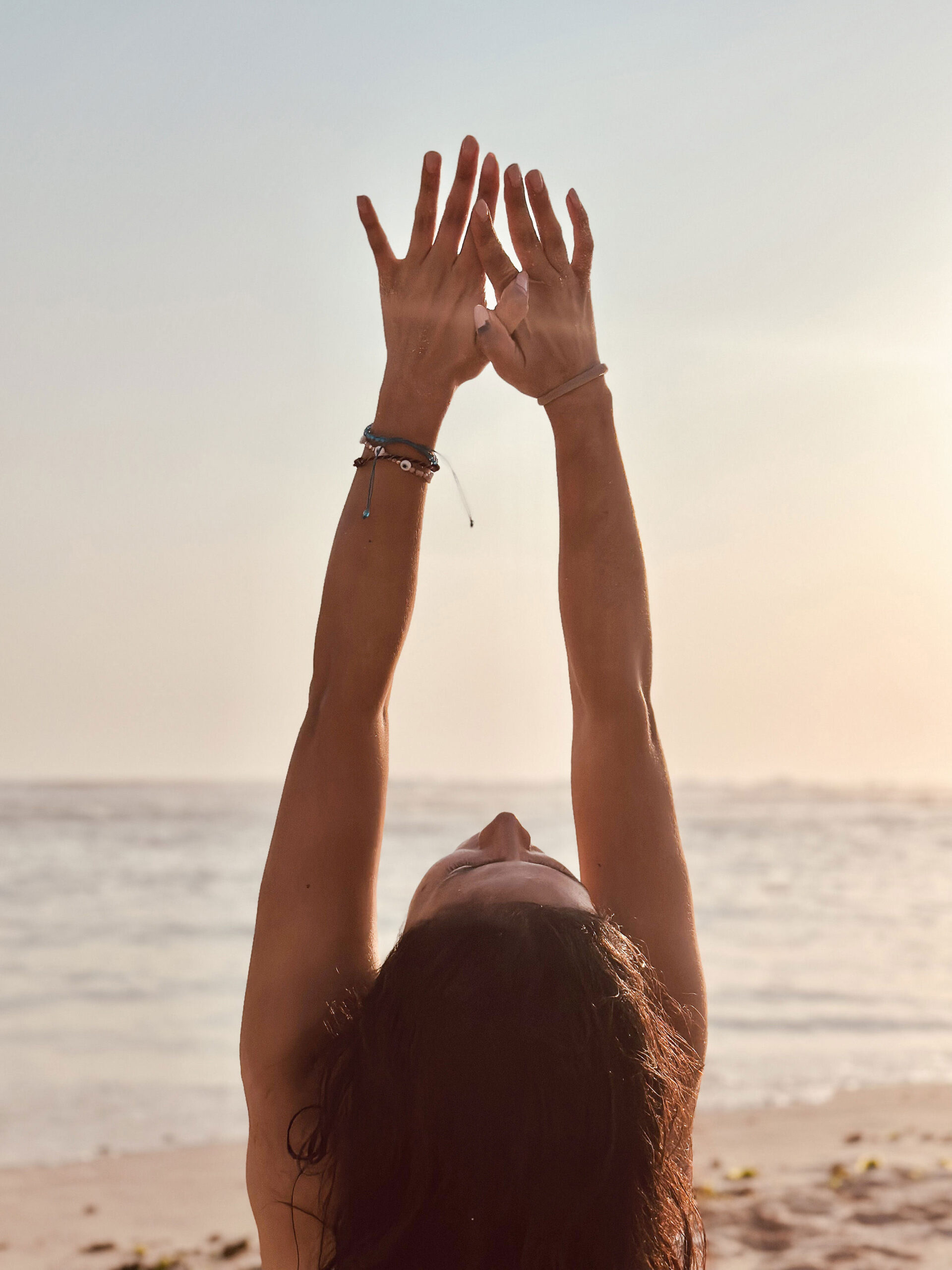
You know that heavy feeling when you wake up and the day already feels like too much? When even the thought of getting out of bed requires more energy than you think you have?
If this sounds familiar, you’re not alone. As a psychiatric nurse practitioner who has spent over 15 years working specifically with women navigating their 60s and beyond, I hear these words almost daily. And here’s what I want you to know right away: there is something gentle, accessible, and deeply effective that can help—and it doesn’t require a 90-minute class, a fancy yoga studio, or even getting on the floor.
I’m talking about gentle yoga for depression—and it may be the medicine you didn’t know you needed.
The Truth About Yoga and Depression (It’s Not What You Think)
When most of us picture yoga, we imagine young, flexible people twisted into pretzels, wearing expensive leggings in beautiful studios. That image can feel like a world away from where we are right now—especially when we’re struggling with low mood or depression.
But here’s what the research actually shows: gentle yoga is one of the most effective complementary approaches for easing depression symptoms, and it works especially well for women in our age group.
A recent review published in Aging and Mental Health looked at various relaxation techniques for depression and anxiety in older adults—including massage therapy, stress management, and music therapy. While all provided some benefit, yoga was the most effective for both depression and anxiety, and appeared to provide the longest-lasting effect.
Even more encouraging? A comprehensive meta-analysis examining over 150 studies found that yoga produced a medium effect size in reducing depression symptoms—and the benefits increased with more frequent practice. But here’s the part that made me smile: participants who practiced yoga even just once or twice a week still experienced significant improvements.
You don’t need to be perfect. You don’t need to practice for an hour. You just need to begin.
Why Yoga Works When Other Things Haven’t
So many of us—especially the nurturers—have spent years taking care of everyone else while putting our own needs last. By the time we reach our 60s, we may find ourselves carrying not just physical tension, but years of accumulated stress, grief, and unexpressed emotion.
Here’s the thing: depression isn’t just “in your head.” It lives in your body too.
When we’re depressed, our nervous system often gets stuck in a state of chronic stress. Our shoulders creep up toward our ears. Our chest caves inward, protecting our heart. Our breath becomes shallow. Our muscles hold tension we don’t even notice anymore.
Gentle yoga works because it addresses both the mind and the body—something most treatments overlook. When you move through simple poses with awareness and breath, you’re actually:
Activating your parasympathetic nervous system. This is your body’s natural “rest and digest” response. Deep, slow breathing—the cornerstone of yoga—triggers this system, lowering cortisol (the stress hormone), calming your heart rate, and sending signals of safety to your brain.
Increasing GABA levels in your brain. GABA is a neurotransmitter associated with calm and reduced anxiety. Research shows that yoga practice can significantly increase GABA levels—something that low mood and anxiety tend to deplete.
Releasing physical tension that feeds emotional heaviness. Tight hip flexors, a collapsed chest, chronic back pain—these aren’t just physical complaints. They can actually reinforce the postural and physiological patterns of depression. Gentle stretching and movement help release this stored tension.
Bringing you into the present moment. Rumination—going over and over negative thoughts—is both a symptom and driver of depression. The mindful focus required in yoga helps interrupt these thought loops, giving your brain a much-needed rest.
Gentle Yoga Is Not “Easy” Yoga—It’s Wise Yoga
Let me be clear about something important: gentle doesn’t mean ineffective, and it certainly doesn’t mean “yoga for people who can’t do real yoga.”
Gentle yoga is wise yoga. It’s yoga that respects where your body is today, not where it was twenty years ago. It’s yoga that honors the accumulated wisdom of your joints, your muscles, and your nervous system.
If you’re an active woman over 60—someone who walks, gardens, plays with grandchildren, perhaps plays tennis or golf—you don’t need chair yoga designed for people with significant mobility limitations. What you need is a practice that meets you where you are: capable, strong, and deserving of movement that feels good.
Here’s what gentle yoga looks like for fit, active women in their 60s and beyond:
- Slower pacing that allows you to really feel each movement
- Breath-centered practice where the breath leads and the body follows
- Standing and floor poses modified for your unique body
- Props when helpful—not because you’re “less than,” but because props are tools for deeper practice
- Focus on spine mobility, hip opening, and chest expansion—areas that tend to become restricted as we age and that directly affect mood
The CDC recommends at least 150 minutes of moderate-intensity exercise per week for older adults, and most yoga qualifies as exactly that. But research suggests that practicing yoga even twice weekly can decrease anxiety and depression. That’s roughly 20-30 minutes, twice a week. Manageable, yes?
Your 5-Minute Morning Yoga Routine for Mood
I promised you something practical, and here it is: a simple 5-minute morning routine specifically designed to lift mood and ease the weight of depression.
This is not about achieving perfect poses. This is about waking up your body, inviting in breath, and starting your day from a place of gentle intention. You can do this in your pajamas, beside your bed, without any special equipment.
Pose 1: Mountain Pose with Breath Awareness (1 minute)
Stand with your feet hip-width apart, weight evenly distributed. Let your arms hang naturally at your sides. Close your eyes if that feels comfortable.
Take three slow, deep breaths. As you inhale, imagine drawing breath all the way down into your belly. As you exhale, let your shoulders soften away from your ears.
Why this helps: This simple standing pose grounds you in your body and signals to your nervous system that you’re safe. Standing tall—even when you don’t feel like it—can shift your mood more than you might expect.
Modification: If balance is a concern, stand near a wall or chair for support.
Pose 2: Cat-Cow Flow (1.5 minutes)
Come to hands and knees on a yoga mat, rug, or even your bed. Align your wrists under your shoulders and your knees under your hips.
As you inhale, let your belly drop toward the floor, lift your chest, and gaze gently upward (Cow Pose). As you exhale, round your spine toward the ceiling, tucking your chin toward your chest (Cat Pose).
Move slowly between these two positions for 6-8 breath cycles, letting your breath guide the movement.
Why this helps: This gentle flow awakens the spine, releases overnight stiffness, and coordinates breath with movement—a cornerstone of yoga’s mood-lifting effects. The rhythmic motion is deeply soothing to the nervous system.
Modification: If your wrists are sensitive, make fists and rest on your knuckles, or fold your mat for extra cushioning. You can also do this seated in a chair, placing hands on your knees and rounding/arching your seated spine.
Pose 3: Standing Forward Fold (1 minute)
Stand with feet hip-width apart. Take a deep breath in. As you exhale, hinge at your hips and let your upper body fold forward, allowing your head and arms to hang heavy.
Bend your knees as much as you need to—this isn’t about touching your toes. Let gravity do the work. Stay here for 5-6 slow breaths.
To come up, bend your knees deeply and slowly roll up one vertebra at a time.
Why this helps: Forward folds are gentle inversions that increase blood flow to the brain and activate the parasympathetic nervous system. Many women describe feeling an almost instant sense of calm from this pose.
Modification: Keep knees deeply bent, or rest your hands on a chair seat for a half-fold if bending over feels uncomfortable.
Pose 4: Gentle Chest Opener (30 seconds)
Stand tall. Interlace your fingers behind your back (or hold opposite elbows if that’s more comfortable). Gently squeeze your shoulder blades together and lift your chest toward the ceiling.
Take 3-4 deep breaths here, feeling your heart space expand.
Why this helps: Depression often manifests as a collapsed, protective posture around the chest. This gentle opener counters that pattern, physically creating the posture of openness and confidence—which can shift your emotional state.
Modification: If shoulders are tight, hold a small towel between your hands behind your back to create more space.
Pose 5: Three Centering Breaths
Return to standing in Mountain Pose. Place one hand on your heart and one hand on your belly.
Take three deep breaths, feeling both hands rise and fall.
On your final exhale, set a small intention for your day—perhaps simply: “I will be gentle with myself today.”
Why this helps: This final centering brings together breath, body awareness, and intention—powerful tools for shifting from stress mode into a state of calm presence.
That’s it. Five minutes. Three poses, a flow, and some conscious breathing.
If you do nothing else, do this. Not perfectly—just consistently. On hard days and easy days alike.
Making It Work for Your Real Life
I want to address something that often goes unsaid: when we’re depressed, even small tasks can feel monumental. The idea of adding one more thing—even something good for us—can feel overwhelming.
So here’s my gentle suggestion: start smaller than you think you need to.
Maybe tomorrow, you just do the Mountain Pose with three breaths. That’s it. Perhaps you do Cat-Cow for one minute while sitting on the edge of your bed. These small moments of mindful movement add up, and they’re infinitely better than doing nothing while waiting to feel “ready” for something bigger.
Some practical tips that have helped my clients:
Anchor it to something you already do. After brushing your teeth, before your morning coffee—attach your practice to an existing habit.
Keep it visible. Put your yoga mat (or even a towel) somewhere you’ll see it first thing in the morning.
Let go of perfection. You don’t need special clothes. You don’t need to look good doing it. You don’t even need to do it “right.” You just need to breathe and move with awareness.
Track gently. A simple checkmark on your calendar can provide a sense of accomplishment without pressure.
When to Seek Additional Support
As much as I believe in the healing power of yoga, I also want to be clear: yoga is a complement to professional care, not a replacement for it.
If your depression is significantly impacting your daily life, please reach out to a mental health professional. If you’re having thoughts of self-harm or suicide, please contact a crisis helpline or your healthcare provider immediately.
Yoga can be a beautiful part of your healing toolkit—alongside therapy, medication if needed, community connection, and the other practices that support your wellbeing. For many women, gentle yoga becomes the daily anchor that helps all the other pieces work better together.
Your Invitation
There is a quiet kind of power in choosing yourself—in taking five minutes each morning to breathe, move, and remember that you matter.
Depression wants us to believe we’re stuck, that things won’t change, that we don’t have the energy for anything new. But here’s what I’ve witnessed in over 15 years of working with women in their 60s and beyond: small, gentle practices done with consistency can create profound shifts.
You don’t need to be flexible. You don’t need to be fit. You don’t need to have practiced yoga before. You just need a willingness to try—and a little bit of compassion for wherever you are right now.
Tomorrow morning, I invite you to stand beside your bed, take three deep breaths, and notice how it feels to simply be in your body. That’s where it begins.
Here’s to gentle mornings and brighter days ahead.
Sweet dreams 🌸✨
Related Posts You Might Enjoy:
- The Sleep Secret to Preventing Alzheimers
- The Gentle Power of Body Scan Meditation
- Navigating Grief and Loss in Later Life
Ready to Take the Next Step?
If you’re struggling with sleep alongside depression—and most women are—you might find my Sweet Dreams After 60 program helpful. This comprehensive course addresses the interconnected challenges of sleep disruption, anxiety, and mood changes that commonly affect women in our age group.
[Learn More About Sweet Dreams After 60]
Resources:
- Harvard Health – Yoga for Better Mental Health: https://www.health.harvard.edu/staying-healthy/yoga-for-better-mental-health
- NIH/PMC – Yoga for Healthy Aging: https://pmc.ncbi.nlm.nih.gov/articles/PMC8341166/
- CDC – Physical Activity Guidelines for Older Adults: https://www.cdc.gov/physical-activity-basics/guidelines/older-adults.html
- NIH/PMC – Effectiveness of Yoga for Major Depressive Disorder: https://pmc.ncbi.nlm.nih.gov/articles/PMC10077871/
Gentle Yoga for Depression: Why 5 Minutes a Day May Be the Medicine You Didn’t Know You Needed
November 25, 2025
meet inge
I’m Inge, a Psychiatric Nurse Practitioner passionate about helping others feel grounded, resilient, and well. Here on the blog, I share insights on mental health, prevention, meditation, clean skincare, and nutrition—everything I turn to in my own daily life. I hope this space becomes a trusted part of your wellness journey.
LATEST FROM THE BLOG


Has this ever happened to you? You wake up exhausted, even though you slept eight hours. Your brain feels foggy—like you’re moving through the world behind a pane of glass. Small tasks feel overwhelming. And maybe there’s a heaviness to your mood that doesn’t quite match your life circumstances. If this sounds familiar, you’re not […]

We’ve all heard the stories whispered in coffee shops and support groups. A mother reaches for her phone to call her adult child, then remembers—the number has been blocked. Another sits at a holiday table with an empty chair, the absence more present than anyone who remains. A grandmother holds a birthday card she’ll never […]

You know that moment… When you wake up in those first days after surgery and the reality hits you: your body feels broken. Your hip, knee, or shoulder—the very joint that’s supposed to carry you through life—is now a source of pain and limitation. Maybe you’re lying there thinking: “I’m too old for this. I’ll […]

Why Deep Sleep Matters More Than You Know How prioritizing your nights could be the most powerful dementia prevention strategy available ============================================================================ YOU KNOW THAT MOMENT… When you drift off to sleep, and your body finally releases the tension of the day. Your mind quiets. Your breathing deepens. For a moment, everything feels… at peace. […]